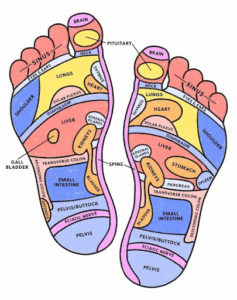The History of Reflexology
Reflexology is an old therapeutic method practiced by the ancient Egyptians, early Chinese, and North American Indian tribes for many centuries. In the early 20th century, Dr. William Fitzgerald, a US ear, nose, and throat specialist, observed that by applying pressure to the specific regions of the hands and foot, an anesthetizing effect could be induced in the other parts of the body.
Using his findings, Dr. Fitzgerald divided the body into ten longitudinal zones (five on the left side of the body and five on the right), terminating in the fingers and toes. He suggested that there is a direct link between the organs that are located in each zone. Later on, Dr. Ingham completed his work by charting the reflex areas in the feet, which correlate to the entire human body (depicted below).

How Does Reflexology Work?
In reflexology, pressure is applied to the reflex zones on the hands and feet of the patient to produce a specific effect on their related organs. Reflexologists usually prefer to work on the feet due to their accessibility, larger contact area, and sensitivity compared to the hands. They move their hands in a caterpillar-like movement over each zone. The observation or sensation of a tender or painful area in any zone indicates energy depletion or blockage in its corresponding organ in the body, thus an area of imbalance. The crystalline deposits of calcium or uric acid may also be detected during the reflexology session, which can be broken down by hand pressure. This pressure will help faster removal or reabsorption of these deposits and improve the systemic blood circulation in the body. This process is known as detoxification and may result in reflexology detox symptoms (a.k.a. healing crisis), depending on the location of the toxins. For instance, the detoxification process in the respiratory system (lungs and airways) may result in flu-like or cold symptoms, and detoxification in the digestive system may cause diarrhea.
Benefits of Reflexology
Reflexology is used to alleviate or treat different health conditions in the body, specifically those of chronic nature, including arthritic and sciatica pain, gastrointestinal problems and disturbances, menstrual and skin problems, and stress-related conditions such as anxiety, migraine, and asthma.
Reflexology significantly induces relaxation in the body, resulting in the organs’ self-healing or prevention of future health issues. Reflexology also enhances systemic blood circulation, resulting in pain relief, freedom from congestion, increased joint mobility, and a desire to sleep. It has also been suggested that reflexology or zone therapy can boost the immune system, improve wound healing, and reduce insomnia. Moreover, it can relieve the symptoms in patients with chest pain, shortness of breath, and cystic fibrosis.
After several reflexology sessions, patients suffering from multiple sclerosis (MS) have reported improved mental condition, moving abilities, decreased pain, improved digestive function, and improved stamina (read more here).
Reflexology is a popular complementary therapy among cancer patients in the United Kingdom. Studies have shown that this method can help relieve anxiety, pain, and stress in cancer patients and improve their feeling of well-being (Cancer Research UK).
Reflexology Side Effects and Limitations
Reflexology is generally safe and does not have any specific side effects. Zone therapy induces relaxation in the body; thus, you probably feel relaxed or light-headed during or after each reflexology session. You may also feel tenderness in your feet, show emotional responses, or need to pass the urine after each treatment session. Due to crystalline deposits of calcium or uric acid, applying pressure in some areas of the feet can be slightly painful or uncomfortable.
If you have cancer, you must visit a reflexologist trained or experienced in working with cancer patients. There might be a specific zone on the feet that they should avoid applying any pressure, or a very gentle pressure should be applied.
If you have type 1 or 2 diabetes, you also need to consult with your doctor before a reflexology treatment, which may interfere with the drugs you are taking for your current health condition.
If you have the following health condition, you also should avoid reflexology:
-
Gout
-
Blood circulation issues in the feet
-
Blood clots or inflammation in the leg veins
-
Foot ulcers
-
Fungal infections such as athlete’s feet
-
Thyroid issues
-
Epilepsy
Reflexology Certification and Practice
Studies suggest that reflexology is a helpful complementary intervention to reduce anxiety and stress and has numerous other benefits for the human body. By reading this article, you might become interested in practicing reflexology, but you should note that a reflexologist should be trained appropriately by a reputable certifying organization.
Our Centre of Wellness provides an intensive online reflexology course that enables our trained practitioners to provide their clients with a complete one-hour reflexology treatment. After our reflexology training, you will be able to identify and activate the stimulus points in your clients’ hands and feet and induce the numerous advantages of zone therapy in their bodies. Contact us today if you are interested to know more about our online reflexology course.
